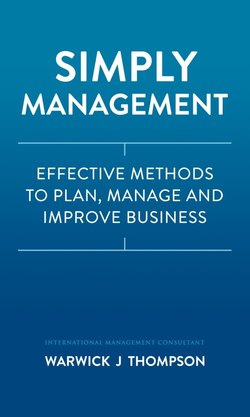Читать книгу Simply Management: Effective Methods to Plan, Manage, and Improve Businesses - Warwick J Thompson - Страница 4
На сайте Литреса книга снята с продажи.
INTRODUCTION
ОглавлениеWhere should a small book about management begin?
It should commence the same way that I think approaching managing a business itself should begin – strategize, then organize. Therefore this book begins with a discussion about Strategy and then follows with Organization & Management.
The reason for this is that the first task in any business, business venture or operating sector of a business is to devise a viable strategy. Then having devised strategy, we organize the business so as to implement it.
All too frequently, these two tasks are put back to front and we rush to organize, before we have a clear, cogent and viable strategy in place.
Why does this happen?
Devising strategy is difficult. It is ethereal and abstract. Our brains are wired to prefer thinking in the concrete rather than the abstract. It requires hard thinking. There are generally no clear paths to follow, no list of steps to tick off mechanically. Usually there is nobody to help us. It can be like trying to find gold, in a fog, when we don’t even have a clear idea of what gold is or even what it looks like.
So we plunge into business pursuing some general or vague ideas of what we will try and do and we proceed to organize ourselves.
Organizing is fun. Organizing is doing. It’s usually constructive - we see something tangible for our efforts. We get lots of support. There are always plenty of people climbing over each other to help us; they want to provide us with their products and services and they want to take our money. We get satisfaction from seeing things taking shape, being put in place; it creates and reinforces a strong sense that we are achieving something. But that is a delusion.
We wouldn’t sensibly hire a team of accountants if the intended focus of our business endeavour was marketing & sales. We wouldn’t commit to leasing a warehouse if our business intention was the writing of software. Yet all too often, we put strategy and organizing back to front.
In most other aspects of our personal daily lives, we get the sequence right. We think about the meal we’ll prepare before we go and buy the ingredients. We conceive the idea to go somewhere and how best to get there, before we catch the plane or take the car. Most times, we have a vision of what we would like to become in life before we begin the training or study required to achieve that objective.
But generally, all those aspects of our private lives where we get it right, don’t involve any competition, (unless it’s for a place in the class or secure a new job). The ‘strategy’ part has no competitive element to it.
Business strategy is competitive. It is a competition with others in ideas and methods, or a competition of positivity with negativity, or progress and change with the status quo. It can mean conflict. So it is difficult and our human nature prefers to avoid the difficult and thus we would rather organize and feel more comfortable we are doing something constructive, instead.
What follows in this little book therefore follows another of my Management Maxims: First devise the strategy – then organize to implement it.
